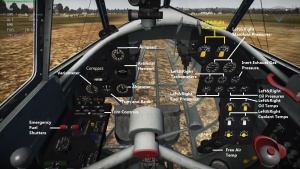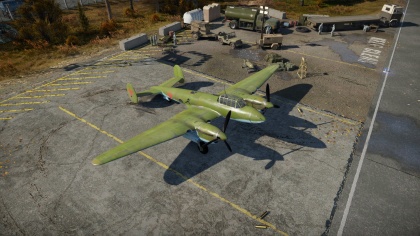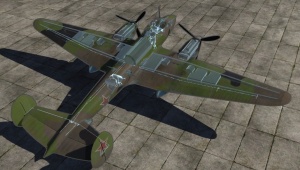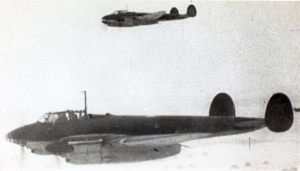Pe-2-83
Contents
| This page is about the aircraft Pe-2-83. For other uses, see Pe-2 (Disambiguation) |
Description
The Pe-2-83 Peshka is a Rank II Soviet dive bomber with a battle rating of 4.0 (AB/RB/SB). It was in the game since the start of the Open Beta Test prior to Update 1.29.
The Pe-2 fulfils much the same attack craft role as the IL-2. While the armament is a mix of MGs and therefore worse than the IL-2's, it can carry much heavier bombs, allowing it to destroy targets in one hit that a Sturmovik might take two or three bombs to destroy. Additionally, its nose-mounted weaponry, ability to mount rockets, and fact that it spawns at bomber altitude in Arcade make it a surprisingly effective bomber hunter in a pinch. However, as in other attack craft, you should have a friendly cover you whenever possible. While it has a decent amount of defensive guns and is faster than the Sturmovik, it is still very vulnerable when caught alone. Further, it is very vulnerable to diving attacks due to its dorsal-mounted fuel tank.
However, there are disadvantages as well. The fixed armament is inadequate at best. Two nose-mounted machine guns simply lack the punch of cannons and their low ammunition supply prevents prolonged usage. The defensive armament is not any better – the upper and lower hemisphere of the aircraft are each defended only by a single 7.62 mm machine gun, with the ventral turret having an extremely limited field of view and the side mounts being largely redundant. Your best defence is then the Pe-2’s agility and speed. When attacked by enemy fighters, use your speed to run away and your agility to dodge gun passes until you have reached friendly fighters or strong allied AAA.
Fast, agile and very versatile, the Peshka can be a great bomber if used correctly and its niche lays in tank battles, as a precise dive bomber. Further research of this line will then lead you to even faster and better-armed variants. Notably 128 mm rockets, excellent for tank attacks and the occasional bomber.
General info
Flight Performance
| Characteristics | |||||||
|---|---|---|---|---|---|---|---|
| Stock | |||||||
| Max Speed (km/h at 5,100 m) |
Max altitude (meters) |
Turn time (seconds) |
Rate of climb (meters/second) |
Take-off run (meters) | |||
| AB | RB | AB | RB | AB | RB | ||
| 487 | 476 | 8,400 | 30.2 | 31.4 | 6.5 | 6.5 | 326 |
| Upgraded | |||||||
| Max Speed (km/h at 5,100 m) |
Max altitude (meters) | Turn time (seconds) | Rate of climb (meters/second) |
Take-off run (meters) | |||
| AB | RB | AB | RB | AB | RB | ||
| ? | ? | 8,400 | ??.? | ??.? | ?.? | ?.? | 326 |
Details
| Features | ||||
|---|---|---|---|---|
| Combat flap | Take-off flap | Landing flap | Air brakes | Arrestor gear |
| ✓ | ✓ | ✓ | ✓ | X |
| Limits | ||||
|---|---|---|---|---|
| Wing-break speed (km/h) |
Gear limit (km/h) |
Combat flap (km/h) |
Max Static G | |
| + | - | |||
| 740 | 450 | ??? | ~8 | ~4 |
| Optimal velocities | |||
|---|---|---|---|
| Ailerons (km/h) |
Rudder (km/h) |
Elevators (km/h) |
Radiator (km/h) |
| < 380 | < 380 | < 440 | > 250 |
| Compressor (RB/SB) | ||
|---|---|---|
| Setting 1 | ||
| Optimal altitude | 100% Engine power | WEP Engine power |
| 2,000 m | 2,200 hp | 2,372 hp |
| Setting 2 | ||
| Optimal altitude | 100% Engine power | WEP Engine power |
| 4,000 m | 2,100 hp | 2,265 hp |
Survivability and armour
- 8 mm Steel plate behind the pilot.
- 4 mm Steel plate in front of the dorsal gunner.
- 4 mm Steel plate in the ventral turret.
- No armour glazing
- Critical components located at front of aircraft (fuel, pilot, engine, controls)
- More fuel tanks located in wings near fuselage
Armaments
Offensive armament
The Pe-2-83 is armed with:
- 1 x 12.7 mm Berezin UB machine gun, nose-mounted (150 rpg)
- 1 x 7.62 mm ShKAS machine gun, nose-mounted (450 rpg)
Suspended armament
The Pe-2-83 can be outfitted with the following ordinance:
- 6 x 100 kg FAB-100 bombs (600 kg total)
- 4 x 100 kg FAB-100 (forged) bombs + 2 x 250 kg FAB-250M43 bombs (900 kg total)
- 4 x 250 kg FAB-250M43 bombs (1,000 kg total)
- 2 x 500 kg FAB-500 bombs (1,000 kg total)
- 10 x 132 mm RS-132 rockets
- 10 x 132 mm RBS-132 rockets
Defensive armament
The Pe-2-83 is defended by:
- 1 x 12.7 mm Berezin UB machine gun, dorsal turret (200 rpg)
- 1 x 12.7 mm Berezin UB machine gun, ventral turret (200 rpg)
- 1 x 7.62 mm ShKAS machine gun, 2 x beam turret (225 rpg = 450 total)
Usage in the battles

Most versatile and useful payload variant is the 2 x 250 kg + 4 x 100 kg option. Those dual outside mounted 250 kg bombs do NOT drop in pairs as usual (RB/SB effect). The same applies to 2 x 500 kg payload. Each one drops single upon pressing the release button. Beware though: The unlockable payload options take a big toll on climb rate, acceleration and speed. For quick and speedy mission, the stock six times 100 kg bombs all mounted inside remains a very good choice.
The ten rockets payload is worth a look too. If compared to the highest quantity bomb loads with six single drops each. This option can engage four target more in Arcade, but one less than in RB/SB as the rockets are fired in pairs. The RS-132 is derived from the Katyusha artillery and therefore quite potent. However 100 kg bombs are stronger in overall strength and depending on the terrain easier to deliver. Rockets however only require aim with the crosshair, allowing for unobstructed view and a direct approach. Especially the former point is on often overlooked advantage. A third difference is the delivery time, rockets are just faster at the target. A big advantage versus moving targets. And they can double as anti-air armament, a department where the Pe-2s are severely lacking.
Manual Engine Control
| MEC elements | ||||||
|---|---|---|---|---|---|---|
| Mixer | Pitch | Radiator | Supercharger | Turbocharger | ||
| Oil | Water | Type | ||||
| Controllable | Not controllable | Not controllable | Not controllable | Separate | Not ontrollable | Not controllable |
Modules
| Tier | Flight performance | Survivability | Weaponry | |||
|---|---|---|---|---|---|---|
| I | Fuselage Repair | Radiator | Offensive 7 mm | Turret 7 mm | DZ-40 | |
| II | Compressor | Airframe | New 7 mm MGs | New 7 mm MGs (turret) | ||
| III | Wings Repair | Engine | Offensive 12 mm | Turret 12 mm | RO-132 | |
| IV | Engine Injection | Cover | New 12 mm MGs | New 12 mm MGs (turret) | ||
The first rank of upgrades are rather uninteresting. Take either two out of three to unlock research for Tier 2.
DZ-40 first to unlock more payload variants. Afterwards the only thing to worry about is performance. Acceleration takes a hit with the new heavier payloads.
Useful and in order of research are: Compressor, Engine, Wings repair, Engine Injection & Cover. The remaining upgrades can be chosen in any order.
Pros and cons
Pros:
- Nose mounted weaponry
- Versatile bomb load for an attack craft
- Rather maneuverable for a twin-engine attack craft
Cons:
- Large target
- Woefully inadequate offensive armament
- Large fuel tank in the midsection makes it vulnerable to fires
History
Originally, the Petlyakov Pe-2 was not supposed to be a bomber at all. Its direct predecessor, designated VI-100, was designed by a prison design bureau team led by Vladimir Petlyakov as a high-altitude escort fighter. The VI-100 was very modern for its time, featuring a pressurized two-seat cockpit, electrically actuated systems and all-metal construction, and was powered by two supercharged Klimov M-105 V-12 inline engines producing 1100 horsepower each. The prototype was completed in 1939 and during its first test flight on 7th May 1939 it reached a top speed of 627.6 kph (390 mph) – an astounding performance for its time. The results of flight tests were so promising that the VI-100 was ordered into production.
However, Germany launched the “Blitzkrieg“ campaign in September 1939. Aside from their revolutionary usage of tanks, the campaign in Poland featured notable usage of Ju 87 dive bombers and showed their potential. Consequently, the Soviet authorities ordered the VI-100 to be redesigned as a dive bomber. Pressurization equipment and engine superchargers were removed, dive brakes were installed under the wings and the bombardier position was added to the nose of the aircraft(raising the number of crew members to three). A ventral bomb bay was added along with the two smaller bomb positions located at the rear of engine nacelles. Two rear-facing turrets, each armed by a single ShKAS machine gun, were installed to dorsal and ventral positions. Resulting aircraft, able to carry up to 1600 kg / 3520 lbs of bombs, was designated PB-100. The first prototype flew on 15th December 1940 and its performance (top speed of 540.7 kph/336 mph) was so good that Vladimir Petlyakov was released and the aircraft was named after him, thus receiving the designation Petlyakov Pe-2. The bomber was then rushed into serial production and deliveries to combat units began in the spring of 1941. The deliveries were, however, slow and by the time of the German invasion in June 1941, only about 458 Pe-2’s were delivered.
The Pe-2, nicknamed Peshka ("Pawn") by its crews, quickly proved itself to be an effective dive bomber and together with the Ilyushin Il-2 Sturmovik attacker, it became the most important offensive weapon of the Soviet Army Air Force. The bomber was fast and agile enough to be an elusive target for German fighters and also proved its versatility – it was used for reconnaissance and artillery spotting and also became the basis for the Pe-3 heavy fighter. Losses were heavy, however. Crews often complained about a lack of armour protection for the cockpit and fuel tanks as well as poor defensive armament and unreliable dive brakes, which sometimes failed to retract and allowed top speeds of only around 300 kph (186.4 mph), making the fast bomber easy prey.
Ingame description
Air battles during the first year of the war clearly showed that the Pe-2's armament did not provide effective self-defense. The Pe-2's Achilles' heel was it defense against attacks from the upper rear. This area was covered by the ShKAS machine gun in the TSS-1 mount, installed in the navigator's cockpit. The TSS-1 was inconvenient and had a narrow field of fire. The ShKAS machine gun, with its rifle caliber, proved to be too weak a weapon against German fighters.
In 1942, the Pe-2FT ("FT" meaning “front-line request") was designed as a response to the front-line units' requests to significantly upgrade the aircraft's armament. The TSS-1 pivot mount was replaced with a FT turret equipped with a large-caliber 12.7 mm UBT machine gun with 200 rounds, which had been designed as quickly as possible (using some parts and assemblies from the MV-2 hatch mount) by a team of Factory No. 22 designers headed by L. L. Selyakov.
The opening in the rear section of the navigator's cockpit was increased to accommodate the cumbersome FT mount and provide a good firing angle. However, the long-barreled UBT machine gun could not be folded up in a travel position in the fuselage as the ShKAS machine gun from the TSS-1 mount could. So the rear section of the canopy, the so-called "turtle," was simply removed.
The main advantage of the FT mount was the ease of its mounting on the aircraft. The airframe structure had to be altered only minimally. Introduction of the new turret had virtually no effect on the number of aircraft produced. They began to introduce the FT mount on some Pe-2s beginning with series 83, but it was only installed on all production planes as late as series 87.
The first Pe-2s with the navigator's new large-caliber machine gun saw its first operational trial near Kerch in April 1942. The new weapon immediately demonstrated its high efficiency.
Some FT mounts were manufactured in the form of factory conversion kits to be installed on earlier series Pe-2s by combat units. It was not difficult to mount the new armament; two mechanics could typically perform the installation of the new weapon in 4 to 6 hours.
Media
An excellent addition to the article will be video guides, as well as screenshots from the game and photos.
Read also
Sources
Paste links to sources and external resources, such as:
- topic on the official game forum;
- page on aircraft encyclopedia;
- other literature.
| USSR bombers | |
|---|---|
| SB and Ar | SB 2M-100 · SB 2M-103 · SB 2M-103 MV-3 · SB 2M-103U · SB 2M-103U MV-3 · SB 2M-105 · Ar-2 |
| Yer-2 (petrol) | Yer-2 (M-105) · Yer-2 (M-105) TAT · Yer-2 (M-105R) TAT · Yer-2 (M-105R) LU |
| Yer-2 (diesel) | Yer-2 (ACh-30B) (e) · Yer-2 (ACh-30B) (l) |
| Tu | Tu-2 · Tu-2S · Tu-2S-44 · Tu-2S-59 · Tu-4 |
| Pe | Pe-2-1 · Pe-2-31 · Pe-2-83 · Pe-2-110 · Pe-2-205 · Pe-2-359 · Pe-8 |
| IL | DB-3B · IL-4 |
| Po | Po-2 · Po-2M |
| Other | MBR-2-M-34 · TB-3M-17-32 · Yak-4 · Be-6 |
| Lend-Lease | ▂PBY-5A Catalina · ▂Hampden TB Mk I · ▂A-20G-30 · ▂B-25J-30 |







